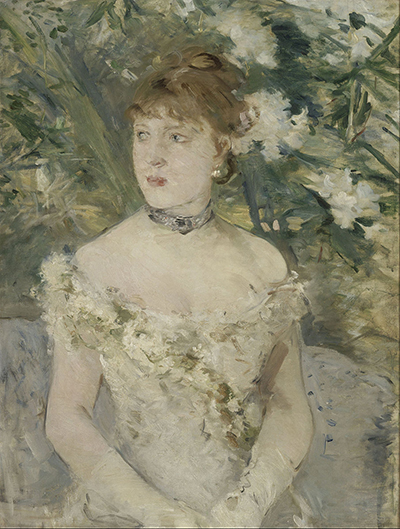Young Girl in a Ball Gown captures many signature elements of the French Impressionist movement and was completed by Berthe Morisot in 1879. It now resides within the permanent collection of the Musée d’Orsay, Paris.
The composition features a lady looking off to her right hand side whilst stood front on in the foreground. She is dressed in a stunning ball gown, whilst holding her hands together in a polite, feminine manner. Behind her is a flurry of oil which perhaps signifies flowers across a coloured wall, but it is hard to tell because of the loose nature of the brushwork. There also appears to be a low-hanging piece of furniture just behind her, suggesting that she might be positioned in the corner of a room, perhaps awaiting a theatrical performance. The woman's dress is decorated with flowers and floral patterns, and she also wears some jewellery, with earrings and a necklace. There are also long gloves which are typical of the period and represent a highly formal occasion. The original artwork is sized at 71cm in height and 54cm in width.
Morisot was, perhaps surprisingly, given more support by critics than her male counterparts within the Impressionist movement. This painting, for example, was well received. Some have argued that it displays elements of Manet's approach, stylistically, but it felt entirely in keeping with Morisot's approach across the late 1870s. Women dominated her oeuvre, but women in ball gowns would also be covered by many male painters in and around the Impressionist movement. Degas, for example, featured dancers and theatre attendees many times, capturing the lives of the privileged and helping us to learn more about life in France at that time for those lucky enough to enjoy considerable amounts of leisure time. Head to the Musée d’Orsay in Paris to see this stunning artwork in person.
In terms of related artworks by Degas, you might recall the likes of Blue Dancers, Ballet Class and Orchestra Musicians. There were several themes which appeared within most of the Impressionist artist's careers, with landscapes of France being very common, as well as some cityscapes too. The social lives of the wealthy middle and upper classes also appear many times, though each artist would favour these subjects in different ways. Morisot, of course, focused on the lives of women and tended to focus on indoor, domestic scenes. It was important to have artists such as this as otherwise art would become too closed on some parts of society, and needs to capture all sectors of society in order to allow us to learn more about that time.




